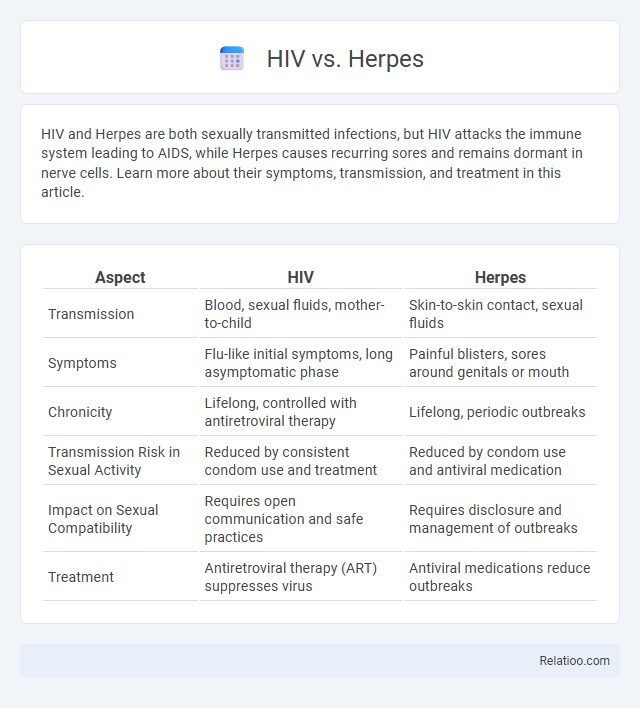HIV and Herpes are both sexually transmitted infections, but HIV attacks the immune system leading to AIDS, while Herpes causes recurring sores and remains dormant in nerve cells. Learn more about their symptoms, transmission, and treatment in this article.
Table of Comparison
| Aspect | HIV | Herpes |
|---|---|---|
| Transmission | Blood, sexual fluids, mother-to-child | Skin-to-skin contact, sexual fluids |
| Symptoms | Flu-like initial symptoms, long asymptomatic phase | Painful blisters, sores around genitals or mouth |
| Chronicity | Lifelong, controlled with antiretroviral therapy | Lifelong, periodic outbreaks |
| Transmission Risk in Sexual Activity | Reduced by consistent condom use and treatment | Reduced by condom use and antiviral medication |
| Impact on Sexual Compatibility | Requires open communication and safe practices | Requires disclosure and management of outbreaks |
| Treatment | Antiretroviral therapy (ART) suppresses virus | Antiviral medications reduce outbreaks |
Overview: Defining HIV and Herpes
HIV (Human Immunodeficiency Virus) is a chronic viral infection that targets the immune system, specifically CD4 cells, leading to immunodeficiency and increased vulnerability to opportunistic infections. Herpes, caused primarily by Herpes Simplex Virus types 1 and 2 (HSV-1, HSV-2), results in recurrent painful sores typically affecting the oral or genital regions. Both HIV and Herpes are sexually transmitted infections (STIs), but HIV progressively impairs immune function while Herpes remains a lifelong condition characterized by episodic outbreaks and viral shedding.
Causes and Transmission Methods
HIV is caused by the human immunodeficiency virus, which is primarily transmitted through unprotected sexual contact, sharing needles, and from mother to child during childbirth or breastfeeding. Herpes is caused by the herpes simplex virus (HSV-1 or HSV-2) and spreads mainly through direct skin-to-skin contact, including oral, genital, and anal sexual activities. Sexually transmitted infections (STIs) encompass a range of pathogens such as bacteria, viruses, and parasites, and transmission occurs predominantly via vaginal, anal, or oral sex with an infected partner.
Key Differences in Symptoms
HIV primarily causes flu-like symptoms initially, followed by prolonged immune system deterioration, whereas herpes presents with painful blisters and sores around the genitals or mouth that can recur over time. Sexually transmitted infections (STIs) encompass a broad range of diseases, each with distinct symptoms such as unusual discharge, itching, or burning sensations, which may not always be visible. Understanding these symptom differences helps Your early detection and prompts timely medical consultation for appropriate treatment.
Diagnosis: Testing for HIV vs Herpes
HIV diagnosis primarily relies on antibody and antigen tests, including fourth-generation combination assays that detect both HIV antibodies and the p24 antigen, offering high sensitivity within 2-6 weeks post-exposure. Herpes simplex virus (HSV) diagnosis commonly involves polymerase chain reaction (PCR) testing for viral DNA from lesion swabs, providing definitive detection, while serologic tests identify HSV antibodies but cannot distinguish between active and past infection. Compared to broad sexually transmitted infection (STI) panels, HIV and herpes tests target specific viral markers, enabling precise identification and timely intervention.
Treatment Options and Management
Treatment options for HIV include antiretroviral therapy (ART), which suppresses viral replication and maintains immune function, significantly reducing morbidity and transmission risk. Herpes management primarily involves antiviral medications such as acyclovir, valacyclovir, or famciclovir to reduce outbreak frequency and severity, as no cure exists. Sexually transmitted infections (STIs) encompass various bacterial and viral pathogens, with treatments tailored accordingly: bacterial STIs like chlamydia and gonorrhea respond to antibiotics, while viral STIs require antiviral management or symptom control.
Long-term Effects and Complications
HIV can lead to severe immune system damage, resulting in opportunistic infections and increased risk of certain cancers over time. Herpes causes recurrent painful sores and may complicate pregnancy or increase susceptibility to other sexually transmitted infections. Understanding the long-term effects of sexually transmitted infections is crucial for your health management and prevention of chronic complications.
Prevention Strategies for Both Infections
Consistent use of condoms significantly reduces the risk of HIV and herpes transmission by providing a barrier against infected bodily fluids and skin contact. Regular testing and early diagnosis help you manage and limit the spread of these sexually transmitted infections (STIs). Avoiding multiple sexual partners and maintaining open communication about STI status are critical prevention strategies for both HIV and herpes.
Myths and Misconceptions
HIV, herpes, and other sexually transmitted infections (STIs) are often surrounded by myths that can obscure the reality of transmission, symptoms, and treatment. You should understand that HIV is a virus that leads to immune system damage, while herpes is a common virus causing painful sores, and both can be managed with proper medical care, but neither is transmitted through casual contact. Many misconceptions, such as thinking all STIs have visible symptoms or that HIV-positive individuals cannot live normal lives, hinder prevention and encourage stigma.
Social Stigma and Mental Health Impact
Social stigma surrounding HIV, herpes, and other sexually transmitted infections (STIs) often leads to social isolation, anxiety, and depression, significantly affecting mental health. Misconceptions and fear about transmission contribute to discrimination, making it harder for individuals to seek diagnosis and treatment, which exacerbates psychological distress. Your mental well-being can be protected by accessing accurate information, supportive healthcare services, and community resources that reduce stigma and promote understanding.
Living with HIV vs Living with Herpes
Living with HIV requires strict adherence to antiretroviral therapy to maintain an undetectable viral load and prevent progression to AIDS, while living with herpes involves managing periodic outbreaks through antiviral medications to reduce symptoms and transmission risk. Both HIV and herpes are sexually transmitted infections (STIs) that impact your immune system and quality of life, but HIV demands ongoing medical monitoring and lifestyle adjustments to ensure long-term health. Effective communication with healthcare providers and safe sexual practices are essential for managing either condition and maintaining overall well-being.

Infographic: HIV vs Herpes
 relatioo.com
relatioo.com